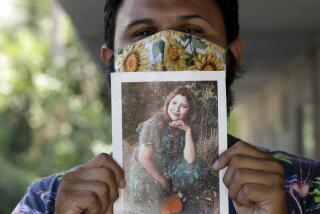Man Is Convicted in Japan of L.A. Murder : Courts: Outcry over slaying of Japanese students is reminiscent of 1981 homicide. In that case, a Tokyo businessman claimed street criminals shot him and his wife. As it turned out, he had staged the slaying.
TOKYO — In 1981, Kazuyoshi Miura parlayed the Japanese stereotype of Los Angeles into an alibi for murder. He told police that his wife was shot dead and he was wounded as they snapped photos in the streets of a metropolis the Japanese regard as one of most violent cities on earth.
As was the case this week in the murders of two students in a San Pedro carjacking, the Japanese outcry was tremendous and the U.S. response was abject. Except that Miura had staged his wife’s murder for his own financial gain, believing he could never get away with it in Japan--but might be able to in Downtown Los Angeles
On Wednesday, in a verdict that capped one of the most sensational international whodunits in Japanese history, the Tokyo fashion importer was convicted of murdering his wife. At a different moment in time, the Tokyo court’s decision might simply have marked the final chapter in a 13-year saga of murder, money and sex.
But on the heels of this week’s international uproar over the carjacking murders of a Japanese-American student and his Japanese friend, the verdict also offered a dark and ironic echo of the long-held Japanese perception of Los Angeles as violent and dangerous.
One commentator on Japan Television, which covered the Miura verdict live, speculated that Miura chose the United States as the scene of his crime “precisely because America is a society of guns.” The recent deaths of Marymount College students Takuma Ito and Go Matsuura, the commentator added, only underscored that point.
Meanwhile, at a news conference called in Los Angeles to announce the Miura verdicts, Dist. Atty. Gil Garcetti could not help but note the similarities in the outrage sparked by the two cases, 13 years apart.
But--like so many public officials in Los Angeles and Washington, D.C., this week--he stressed that the deaths of Ito and Matsuura on Friday night were the result of a random and “uncommon” act of violence.
“I would not have my children living here,” he said, if that was not the case.”
The slaying of Kazumi Miura, on the other hand, was something else entirely.
The case that the Japanese press would eventually dub the “L.A. Shooting Affair” began to unfold on Nov. 18, 1981, on Fremont Avenue two blocks from the Downtown Music Center and nine blocks from police headquarters. Initial news accounts were that Kazumi Miura, 28, of Tokyo, a tourist visiting with her businessman husband, had been taken to County-USC Medical Center in extremely critical condition with a bullet in her head.
Her husband, Kazuyoshi Miura, then 34, had been shot in the leg, in broad daylight on a busy street. Miura told police his wife was cut down before his eyes as he focused on her in his camera viewfinder.
The businessman, an importer who had been coming to Los Angeles on business nearly every month for nine years, told police that the couple had parked their car at 11:45 a.m. and were taking pictures of the Downtown skyline when two young men pulled up in an old, dark green American car and demanded money. When the Miuras hesitated, one of the men pointed a handgun out the car window, shot the Miuras, then hopped out and stole $1,200 from the wife’s purse and the husband’s pockets, Miura said.
Indeed, police noted, several pieces of currency lay fluttering on the sidewalk where the fallen couple lay bleeding.
Miura wasted no time in placing blame on the hateful plague of urban violence, American-style. From his hospital bed, he told reporters that he was writing to then-President Reagan, then-Gov. Edmund G. (Jerry) Brown Jr. and then-Mayor Tom Bradley “to protest this incident and ask proper care and protection against this sort of incident happening again.”
“Many young Japanese will be coming to the U.S. with their dreams on their hearts,” Miura said then. “I strongly hope this accident will never occur again.”
A month later, Miura returned to Japan, leaving his wife in an L.A. hospital. As she had been since the attack, Kazumi Miura, the mother of a 13-month-old child, was blind, paralyzed, unconscious and subsisting on life-support machinery.
At one point, Miura lashed out at the state of California because he had tried and failed to get a crime victims program to subsidize his hospital bills. He did, however, persuade the U.S. government to fly his wife back to Japan in a special U.S. Air Force military hospital jet.
Kazumi Miura died in a Japanese hospital almost a year to the day after the attack, and the furor over the still-unsolved crime died down. Then a series of news articles surfaced in Tokyo in 1984.
Among other things, the accounts noted that Miura had collected 155 million yen (about $655,000) on life insurance policies he had taken out on his wife in the United States and Japan. There was also a bizarre confession to a Japanese newspaper by a onetime Japanese porn actress who told reporters that three months before the shooting, Miura had hired her to kill his wife in their room at the New Otani hotel.
Michiko Yazawa, who said she was Miura’s lover at the time, said Miura had told her that if she eliminated his wife, he would marry her and split $200,000 in insurance benefits. So, she said, she posed as a dressmaker and visited Kazumi Miura at her hotel room, ostensibly to take her measurements. But after smacking the woman several times with a two-pound, hammer-like tool, Yazawa said, she lost her nerve and fled. Miura told authorities his wife had been injured in a bathroom fall.
And then there were questions about the disappearance of another Japanese visitor to Los Angeles--a woman who had earlier been Miura’s accountant and lover. Two years before the shooting, Chizuko Shiraishi, 34, had filed for divorce and hopped a plane to Los Angeles on a 30-day tourist visa, listing a Hollywood Holiday Inn as her destination. The hotel manager told reporters at the time that he had no record of a guest by her name, but that a Mr. and Mrs. Miura had checked in the day she arrived.
The sighting by the hotel manager was the last report that the woman had been seen alive. But her bank records showed that, shortly after her departure, Miura withdrew about $21,000 from her account in Tokyo.
And when a Japanese reporter finally gave her dental charts to a Los Angeles detective in 1984, they were traced to a corpse that had been found in a vacant field in Lake View Terrace two months after Shiraishi disappeared. Jane Doe No. 88 had languished, unidentified, in the county morgue for five years.
The disclosures spawned a media frenzy, as reporters from TV to tabloid magazines raced to dish details of Miura’s life--from his past criminal record to his string of lovers and even half-nude photos of him surrounded by naked women in S & M garb at a sex swap party.
The media overkill actually stirred some public sympathy for Miura, with calls for media responsibility and respect for his rights, and the businessman eventually wrote two books detailing his persecution by the media. In fact, he was just wrapping up a televised denial of any role in his wife’s death when police arrested him at the posh Ginza Tokyo Hotel. Four TV networks broadcast Miura’s arrest.
Initially, Miura was tried only on attempted murder charges, based on the New Otani incident. But after his 1987 conviction on those charges, the investigation of the fatal shooting picked up steam, and authorities from Los Angeles--who had been conducting a parallel probe all along--traveled to Japan to complete their work on the deaths of Miura’s wife and lover.
In 1988, with Miura already serving a six-year sentence for attempted murder, he was finally charged with murder, under a Japanese law that allows its citizens to be prosecuted in Japan for crimes committed in other countries. Also charged was a man who had been a buyer for his company and who police said had acted as his accomplice.
Yoshikuni Matsumoto, an Osaka native who had graduated from USC and had gone on to become Miura’s agent in Los Angeles, was accused of conspiring with Miura to murder his wife. On Wednesday, Matsumoto was exonerated on that charge, but convicted of smuggling a rifle and 100 pounds of ammunition from the United States to Japan. He was sentenced to one year and six months in prison.
Both men are expected to appeal, and Japanese legal experts noted that the split verdict leaves one crucial question unanswered: Who fired the fatal shot?
But for the Japanese media this week, that question was secondary to the point raised by a Japan Television network correspondent:
“The murder of two Japanese exchange students just occurred in Los Angeles,” the correspondent said, “and showed how crime is increasing because of the guns in American society.”
Times staff writer Andrea Ford contributed to this story.
More to Read
Sign up for Essential California
The most important California stories and recommendations in your inbox every morning.
You may occasionally receive promotional content from the Los Angeles Times.











